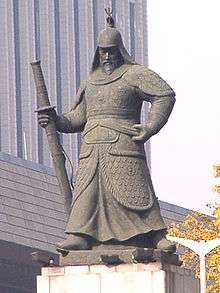Statue of Admiral Yi Sun-sin
The statue of Admiral Yi Sun-sin is located at the Sejongno, Gwanghwamun Plaza in Seoul, South Korea. It is dedicated to the 16th-century Korean war hero, admiral Yi Sun-sin. It is considered one of Seoul's major landmarks and has been called "one of the most important instances of Korean public art".[1][2]

The statue is 17 meters tall and made from bronze (another source has described it as 19m tall, and yet another, as a 6.4m tall statue on top on an 18-meter pedestal).[3][2][4] It depicts a standing figure of the admiral, who is holding a sword in his right hand. A miniature turtle ship, a type of contemporary Korean war vessel commanded by Yi Sun-sin, is also located in front of the statue. Two models of war drums are also present near the statue.[4]
History
This statue was erected on 27 April 1968 in the presence of the presidential pair.[4][5] It was designed by Kim Se-jung (Seechong, 1928–1986), a sculptor and professor of art at Seoul National University, aided by the historians from the National Institute of Korean History. It was the first statue built by the Statue Establishing Committee led by Kim Jong-pil[2] who was asked by President Park Chung Hee: “Build a statue of a person most feared and admired by the Japanese in the Sejong-no intersection.”[5] The raising of the statue, also a part of a renovation of the Gwanghwamun Plaza, was one of the symbols of modernization and rebuilding of Korea.[6] The armored figure of the war hero has also been considered a symbol of the then-military government of South Korea.[2] At the time of its unveiling it was the tallest standing statue in Asia.[2]
In 2005, the South Korean government considered moving a statue to another location, but after a public debate the plans were cancelled.[3] In November 2010, the statue was removed for 40 days to undergo restoration works. Moving for the first time in 42 years, it was lifted by a 200-ton crane and transported to a factory in Icheon, Gyeonggi Province. It underwent sand-blasting to remove rust, accumulated grime such as from roadside pollution; and repainted before returning to the Plaza.[7][8] Other works included fortifying the inner skeleton and the restored statue was unveiled to the public on 23 December 2010.[9] During the time the statue was being renovated, it was replaced by 3 m long, 3 m wide and 6 m high rectangular column displaying life-size photos of the statue.[7] Throughout its four decades, the statue color has changed from bronze to deep green hue and it was decided the renovated statue would be a mix of both colors.[9] During the renovation, Korean public and historians also debated whether his face, sword or armor (the last two criticized by some for being too Chinese or Japanese, and not enough Korean) are accurately represented.
Next to the statue there is also a water fountain in honor of the achievements of Admiral Yi Sun-sin. It is named the 12.23 Fountain, to commemorate the 23 battles he fought with 12 warships, when he led Koreans to victory during the Japanese invasions of Korea. The water jets rises to a height of 18 meters along with 300 smaller jets, which symbolize the battles he fought on the sea.[10] A small museum is located underneath the statue.[11]
Admiral Yi Sun-sin statue is located 250 meters from the other large statue on the Plaza, the statue of King Sejong.[12]
References
| Wikimedia Commons has media related to Yi, Sunsin statue in Seoul. |
- Glionna, John M. (12 December 2010). "South Koreans at sword's point over hero's statue". Los Angeles Times. ISSN 0458-3035. Retrieved 10 March 2017.
- Brown, Rebecca M.; Hutton, Deborah S. (22 June 2015). A Companion to Asian Art and Architecture. John Wiley & Sons. p. 171. ISBN 9781119019534.
- Yacobi, Dr Haim; Fenster, Dr Tovi (28 November 2012). Remembering, Forgetting and City Builders. Ashgate Publishing, Ltd. p. 133. ISBN 9781409488743.
- "Statue of Admiral Yi Sun-Shin (충무공 이순신 동상) | Official Korea Tourism Organization". english.visitkorea.or.kr. Retrieved 9 March 2017.
- "Korea's statues without limitations". Korea JoongAng Daily. Retrieved 10 March 2017.
- "Ever-evolving Gwanghwamun to be altered anew". Korea JoongAng Daily. Retrieved 10 March 2017.
- "Adm. Yi Statue to Undergo Facelift". Chosun Ilbo. 15 November 2010. Retrieved 27 February 2013.
- "Rejuvenated Hero". Chosun Ilbo. 8 December 2010. Retrieved 27 February 2013.
- "Restored Statue of Admiral Yi Returned to Gwanghwamun". Chosun Ilbo. 24 December 2010. Retrieved 8 April 2013.
- Lee, Ji-young (5 September 2009). "Fountains spring to life as city centerpieces". Korea JoongAng Daily. Retrieved 9 June 2018.
- "Two Free Museums in Seoul's Gwanghwamun Square – Bobo and ChiChi". Bobo and ChiChi. 15 October 2014. Retrieved 12 March 2017.
- "Seoul's New Landmark: Gwanghwamun Plaza Now Open | Official Korea Tourism Organization". english.visitkorea.or.kr. Retrieved 11 March 2017.